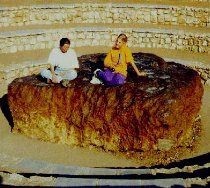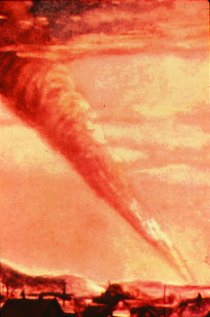 |
Meteorite Charts
The Largest Meteorites
| The largest meteorites found are usually irons. This is due to the fact that iron meteorites are much more stable compared to either stony or stony-iron meteorites. The latter two types
of meteorites often break up into many pieces upon entering the atmosphere, creating the
most impressive phenomenon known as a meteor shower. Moreover, they suffer from the effects of ablation much more than the irons during their passage through the atmosphere. Finally, yet importantly, iron meteorites are much more resistant to
the severe effects of terrestrial weathering, permitting huge iron blocks that fell in ancient times to be preserved until this day. The following lists show the top twenty largest meteorites - the real giants of the three basic types of meteorites. Please note that these lists don't display the total known weight of each distinct fall, but rather the weights of the largest individuals that have been recovered from each fall. |
 |

Hoba - The Largest Meteorite
 |
Iron Meteorites
| Meteorite |
Country |
Found |
Structural Class |
Group |
Weight kg |
| Hoba |
Namibia |
1920 |
Ataxite |
IVB |
60,000 |
| Campo del Cielo |
Argentina |
1990 |
Octahedrite |
IAB |
37,000 |
| Cape York (Ahnighito) |
Greenland |
1894 |
Octahedrite |
IIIAB |
31,000 |
| Armanty |
China |
1898 |
Octahedrite |
IIIE |
23,500 |
| Bacubirito |
Mexico |
1863 |
Octahedrite |
UNG |
22,000 |
| Cape York (Agpalilik) |
Greenland |
1963 |
Octahedrite |
IIIAB |
20,000 |
| Mbosi |
Tanzania |
1930 |
Octahedrite |
UNG |
16,000 |
| Campo del Cielo |
Argentina |
1576 |
Octahedrite |
IAB |
15,000 |
| Willamette |
USA |
1902 |
Octahedrite |
IIIAB |
14,900 |
| Chupaderos |
Mexico |
1854 |
Octahedrite |
IIIAB |
14,100 |
| Mundrabilla |
Australia |
1911 |
Octahedrite |
IIICD |
12,000 |
| Morito |
Mexico |
1600 |
Octahedrite |
IIIAB |
11,000 |
Stony-Iron Meteorites
| Meteorite |
Country |
Found |
Class |
Weight kg |
| Huckitta |
Australia |
1937 |
Pallasite |
1,400 |
| Krasnojarsk |
Russia |
1749 |
Pallasite |
700 |
| Brenham |
USA |
1947 |
Pallasite |
450 |
Stony Meteorites
| Meteorite |
Country |
Fell |
Class |
Group |
Weight kg |
| Jilin |
China |
1976 |
Chondrite |
H5 |
1,770 |
| Norton County |
USA |
1948 |
Achondrite |
Aubrite |
1,073 |
| Long Island |
USA |
1891 |
Chondrite |
L6 |
(broken) 564 |
| Paragould |
USA |
1930 |
Chondrite |
LL5 |
371 |
| Bjurbole |
Finland |
1899 |
Chondrite |
L/LL4 |
(broken) 330 |
The Largest Meteorite Showers
| Only a few meteoroides make their passage through the atmosphere in one piece. Most of them are fragmented on their way due to the high pressures to which they are subjected. Sometimes they may burst into only a few fragments, at other times, into thousands of individual pieces creating a meteorite shower. Only a few pieces from such a shower actually arrive on Earth since all of the smaller fragments usually burn up during their passage. However, sometimes when the initial pieces are big enough, it literally "rains stones", and thousands of meteorites can be collected from huge strewn fields.
One of the most impressive meteorite showers of the 20th
century was the fall of Sikhote-Alin. On February
12, 1947, a huge iron meteoroid exploded over the mountains of
eastern Siberia, Russia. Its fireball was as large as the sun, and
a huge smoke train extended behind it (see the picture on the
right, painted by the eyewitness Medvedev). More than 70 tons of
individuals and fragments have been collected from its strewnfield, making it the largest fall in history.
There is only one comparable prehistoric strewnfield, Campo del
Cielo from Argentina. The following lists show the most prominent meteorite showers of historic and prehistoric times.
>> top...
|
 |

Sikhote-Alin Meteorite Shower
 |
 |
 |
|
|
|
|
|
Historic Meteorite Showers
| Meteorite |
Country |
Fell |
TKW kg |
Individuals |
| Pultusk |
Poland |
1868 |
> 200 |
> 180,000 |
| Holbrook |
USA |
1912 |
> 220 |
> 16,000 |
| Sikhote-Alin |
Russia |
1947 |
> 70,000 |
> 15,000 |
| Allende |
Mexico |
1969 |
> 2,000 |
> 5,000 |
| L'Aigle |
France |
1803 |
> 37 kg |
> 3,000 |
| Mocs |
Romania |
1882 |
> 300 |
> 3,000 |
Prominent Prehistoric Strewn
Fields
| Meteorite |
Country |
Found |
TKW kg |
Individuals |
| Campo del Cielo |
Argentina |
1576 |
> 70,000 |
thousands |
| Gibeon |
Namibia |
1836 |
> 26,000 |
thousands |
| Toluca |
Mexico |
1776 |
> 2,500 |
thousands |
| Brenham |
USA |
1882 |
> 2,400 |
thousands |
| Imilac |
Chile |
1822 |
> 1,000 |
1,000 |
| Plainview |
USA |
1917 |
> 700 |
> 1,000 |
The Oldest Meteorites
When we are talking about the oldest meteorites we are not referring to the absolute age of those meteorites - most of them crystallized during the formation of our solar system and have absolute ages of 4.5 billion years! Instead, we are talking about their terrestrial ages, the time between their initial fall until the present day.
Most meteorites weather away quite quickly in the oxidizing environment of the Earth, while some meteorites may literally be observed as they rust away. However, other meteorites fell at more fortuitous locations and were preserved until this day, e.g. in the ice fields of Antarctica and in the hot deserts of Africa. Some of them have been preserved for as long as 40,000 years or more. Indeed, there are some meteorites found to be much older still - those that have been preserved in sediments or in other geologic strata conducive to preservation, often referred to as "fossil meteorites".
The oldest of these fossils is the meteorite of Osterplana, Sweden, that was found in 1987 imbedded in some limestone. This limestone, which dated from Ordovician times, revealed to the scientists that the imbedded meteorite had fallen 480 million years ago! The meteorite of Osterplana is even older than the Brunflo meteorite which previously held the record for the "oldest". Brunflo, which was also found in Swedish limestone in 1980, has a terrestrial age of 450 million years. As with true fossils, most of the original meteoritic minerals in fossil meteorites has been replaced by terrestrial minerals leaving only the outer structure of the meteorite preserved. Although both meteorites have been classified as chondrites, only their chondritic structure remains as evidence of their extraterrestrial origins.
The oldest intact meteorite is the Lake Murray iron. A single mass with a thick iron-shale was found in a gully in Oklahoma, USA, in 1933. The meteorite was imbedded in some Antler Sandstone dating from the Lower Cretaceous, suggesting that Lake Murray landed in a near-shore, shallow sea, while these beds were being deposited about 110 million years ago! In addition, although the exterior of this meteorite has been heavily corroded, the inner nickel-iron core has remained unaltered, establishing Lake Murray as the oldest meteorite on earth. It literally fell in times when dinosaurs still ruled the
Earth!
>> top...
|

|
 |
